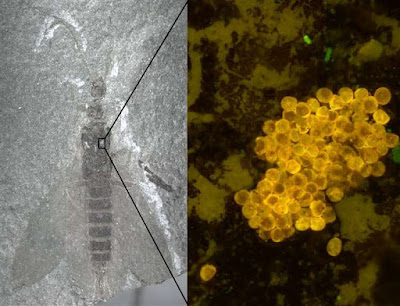 |
| an Permian insect (Tillyardembia antennaeplana) feeding on a pollen cone of ruflorian cordaites in Khramov, Foraponova et Węgierek, 2023. reconstruction by Andrey Atuchin. |
Abstract
Recent fossil discoveries suggest that the coevolution of insect pollinators and gymnosperms started long before the appearance of flowering plants. One of the keys to understanding the origins of pollination relationships is fossil insects with gymnosperm pollen attached to the body surface. Such fossils are exceedingly rare to find, especially from the Palaeozoic, a time when ambers with insect inclusions were absent. Here, we report compression fossils of Early Permian tillyardembiid insects (Polyneoptera) preserved with pollen on their heads, thoraces, legs and abdomens. This is the earliest finding of pollen-bearing insects, predating the previous oldest record from the Middle Jurassic by ca 120 Ma. Judging by the pollen composition, tillyardembiids visited a narrow range of host plants, including Rufloriaceae (Cordaitales). While it is impossible to say for certain whether tillyardembiids as pollen consumers contributed to pollination, a trophic specialization of this kind could be considered an evolutionary precursor of pollination mutualism.
Keywords: Palaeozoic, plant-insect interactions, pollination
 |
| An artistic reconstruction of an Early Permian insect (Tillyardembia antennaeplana) feeding on a pollen cone of ruflorian cordaites. Artwork: Andrey Atuchin. |
Alexander V. Khramov, Tatiana Foraponova and Piotr Węgierek. 2023. The Earliest Pollen-loaded Insects from the Lower Permian of Russia. Biol. Lett. 1920220523. DOI: 10.1098/rsbl.2022.0523

